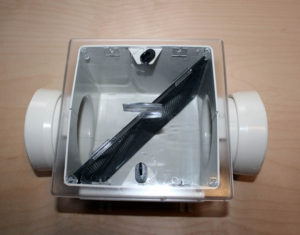Laundry Room Issues
Among all of the safety issues centering around your laundry room, fire hazards are the greatest. The National Fire Protection Association estimates that in the U. S. an average of 15,000 fires occur annually in laundry rooms.
Obviously one of the greatest threats is lint produced by clothes dryer. It is extremely important to clean the lint filter every single time you dry your clothes. Even at this lint still gets past the filter and into the dryer and eventually into the dryer’s duct system. The first thing I recommend is to know exactly where your dryer vent goes through the house and terminates outside the house. If the dryer vent terminates outside adjacent to the dryer you are very lucky.
In many homes the dryer is on an interior wall and the dryer vent has to go up into the ceiling and out from there. In many cases the dryer vent continues through the attic and through the roof. The international residential code states that the maximum allowable length of a dryer vent is 25 feet. Each turn that the dryer vent takes reduces that maximum allowable distance. Clothes dryers do not have enough power to blow all the lint more than just a few feet. As a result lint begins to build up in the dryer and the duct system. This slows down the airflow coming out of the dryer causing the dryer to take longer to dry, work harder, and overheat creating a potential fire hazard.
The first step in making your laundry area a safe place would be to remove any lint that has made it past the dryer filter. If you’re dryer is adjacent to an outside wall this is an easy maintenance issue for you. If the vent goes vertical through wall then cleaning is much more of an issue. Depending on the number of uses the dryer gets per week you may have to do this every six months.
You have two options here. The first option is to pull out dryer and vacuum the flexible dryer hose and the dryer vent in the wall.  The second option is to install a lint trap next to the dryer which will catch the majority of the lint getting past the dryer. In either case it may be necessary to clean under, around, and the interior of the dryer. Make sure the outside wall damper opens with the dryer is being used. Keep the area around the clothes dryer free flammable items. Do not dry items that have come into contact with flammable substances such as alcohol, gasoline, or cooking oils etc. Never operate the dryer when you are either away from home are sleeping.
The second option is to install a lint trap next to the dryer which will catch the majority of the lint getting past the dryer. In either case it may be necessary to clean under, around, and the interior of the dryer. Make sure the outside wall damper opens with the dryer is being used. Keep the area around the clothes dryer free flammable items. Do not dry items that have come into contact with flammable substances such as alcohol, gasoline, or cooking oils etc. Never operate the dryer when you are either away from home are sleeping.


